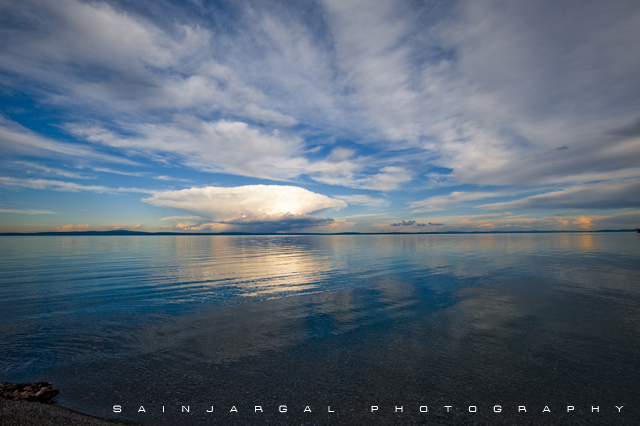The National Park covers 8,381 square kilometers including the lake of Khuvsgul Nuur and its watershed, the Nuur river basin, and parts of Zuni Saran (Khoridol Saridag) mountain. It has been protected since 1992.
Here are special plants such as Adorns sibirica, Yellow Marsh Saxifrage (Saxifrage Hercules), Valeriana officinalis and Saussurea involucrate in the forests.
The taiga forest has Euro Asian Otter, Beaver, Moose, Reindeer, Argali, Siberian Ibex, Snow Leopard, Red Deer, Siberian Roe Deer, Wolf, Brown Bear, Lynx, Wild Boar, Black Stork, Osprey and Curlew. the lake Mountain of Khankh River and Khoroo river has both been designated as “core areas” because of their special importance for migratory birds.
Khuvsgul Lake: Known as the "dark blue pearl" of Mongolia, Lake Khuvsgul is one of he country's largest and most spectacular protected areas. Lake is 136 km long and 36 km wide and located in Khuvsgul province, north western Mongolia. Its 380 cubic km of water make it the fourteenth largest freshwater lake in the world by Volume, with over 1% of the world's fresh water. At its deepest, the lake dives 262 meters.
Lake Khuvsgul located in high mountain, forest. Khuvsgul Lake and its surrounding area 838,000 hectares has established as a National Park in 1992. Khuvsgul shares many similarities in origin, flora, and fauna with its larger and more famous sister, Russia's Lake Baikal, which is just 200 km to the east.
The lake is 1645 meters above sea level and is generally frozen from January until
April or May. The towns of Khatgal and Khankh are situated within the park.
Although every year in June held international marathon here in Huvsgul lake around.
Water and Lake Conditions in Mongolia: Mongolia contains roughly 3,500 lakes with a total lake surface area of 1.6 million ha and a total water volume of 500 cub. km.
Many of these lakes are small and shallow, and many other are salty, especially in the Gobi region.
There are more than 4,000 rivers in Mongolia with a total length of about 67,000 km, 6,900 springs, including 250 mineral water springs, and 187 glaciers. All of these water sources are susceptible to impacts associated with human water use.
Plenty of fish are found in the lake such as: Baikal, Omul, Lenok, Umber, Siberian Grayling and River Perch.
Nearby taiga forest, forest steppe, mountains, and the lake itself provide habitat for 68 species of mammals, including argali, ibex, elk, reindeer, musk deer, brown bear, lynx, marten, beaver, wolf, and moose, 244 species of birds, and 750 species of plants, including 60 with medicinal importance.
Khuvsgul aimag, located in the northern part of Mongolia with its fresh and deep lake of Khuvsgul and Khoridol Saridag mountain range, isolated and deep forests and peculiar customs of many ethnics is the main area of home and foreign tourism in Mongolia. So you could interest in here various destinations and types of tourism such as Biking , Hiking and trekking , Jeep tour , Yak cart tour ,Rock clumbing, Fishing tour , Horse riding tour, Nomadic daily life tour.
Khoridol Saridag mountain Range (3100 m) is situated in North of Khangai mountain range and has eternal snow capped mountain. this area covers the territory of Ulaan uul and Renchinlhumbe soums of Kkhuvsgul aimag and occupies 1886.4square kilometers of land. it was taken uder under state special protection in 1997 by Parliament Resolution 47.
Khoridol Saridag Mountain Range region is descrobed as vertical in that region, such as tundra, taiga, forested steppe and mountainous area, which are greatly different in terms of nature environment and landscape but located close to each other. Due to these characteristic, it is the home of much biodiversity of tundra soil which has become rare and very rare, (S.involucrata, A. altaicum Pall, etc). A part of Argali and Ibex population inhabit this area.
Khoridol Saridag mountain Range (3100 m) is situated in North of Khangai mountain range and has eternal snow capped mountain. this area covers the territory of Ulaan uul and Renchinlhumbe soums of Kkhuvsgul aimag and occupies 1886.4square kilometers of land. it was taken uder under state special protection in 1997 by Parliament Resolution 47.
Khoridol Saridag Mountain Range region is descrobed as vertical in that region, such as tundra, taiga, forested steppe and mountainous area, which are greatly different in terms of nature environment and landscape but located close to each other. Due to these characteristic, it is the home of much biodiversity of tundra soil which has become rare and very rare, (S.involucrata, A. altaicum Pall, etc). A part of Argali and Ibex population inhabit this area.
The people living in Darkhad territory have traditionally engaged in fishing, gathering, and breeding of reindeer. The name Darkhad means blacksmith was given to the local population by the Bogd Gegeen, who became their overlord in the 17th century.
These people live in territory from Mount Khoridol(3,130m)to Mounts Ulaan Taiga (3,351m) Bayan Uul (3,093m), and Munkh Saridag (3,491 m).
Taiga forest has its own laws. People there speak rarely and in low voice. Though they do not welcome outsiders, they do not chase them away.
High ranges of Sayan Mountains covered by thick forests, river valleys of Shishged, Tengis, Bus, and Jams on northern border of Mongolia - these are places where the few remaining families of Tsaatan tribe, known from ancient times as Forest People, are living.


























heaven of earth
ReplyDeleteih medremjtei, gaihaltai zurguud avchee, ene zun zaaval khuvsgul yvj uzii gj bodloo, urid ni khuvsguliin tuhai zurguud zunduu harj bs ch ingej duu aldaj harj bgaagui ym bna. Sainjargald amjilt husiy, bas ih baharhaj bnaa.
ReplyDeletemash goe zuragnuud darsan bnaa mash ih bayrlalaaa:) nadad mash ih medelel ogch chadlaa Khuvsguld torson bj yu ch meddeggui oschee kk
ReplyDeleteuneheer duu aldam zurguud bna, amjilt husie
ReplyDelete